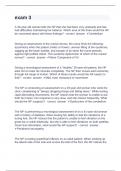-
1. Exam (elaborations) - Advanced health assessment exam np assesment chamberlain college nursing -question an...
-
2. Exam (elaborations) - Advanced health assessment for the nurse practitioner np assesment chamberlain colleg...
-
3. Exam (elaborations) - Advanced physical assessment exam 2 np assesment chamberlain college nursing - questi...
-
4. Exam (elaborations) - Ch 14 np assesment chamberlain college nursing - question and answers rated a+
-
5. Exam (elaborations) - Chapter21 np assesment chamberlain college nursing - question and answers correctly s...
-
6. Exam (elaborations) - Chapter21 np assesment chamberlain college nursing - questions with complete solution
-
7. Exam (elaborations) - Chapter21 np assesment chamberlain college nursing - question and answers rated a+
-
8. Exam (elaborations) - Cranial nerves np np assesment chamberlain college nursing -question and answers alre...
-
9. Exam (elaborations) - Ecu np exam np assesment chamberlain college nursing -question and answers verified t...
-
10. Exam (elaborations) - Exam 1 7470 np assesment chamberlain college nursing - question and answers correctly...
-
11. Exam (elaborations) - Exam 3 np assesment chamberlain college nursing -questions with complete solution
-
12. Exam (elaborations) - Family nurse practitioner np assesment chamberlain college nursing -question and answ...
-
13. Exam (elaborations) - Final np assesment chamberlain college nursing - question and answers already passed
-
14. Exam (elaborations) - Health assessment final np assesment chamberlain college nursing -question and answer...
-
15. Exam (elaborations) - Health assessment np np assesment chamberlain college nursing -question and answers ...
-
16. Exam (elaborations) - Health assessment np np assesment chamberlain college nursing -questions with complet...
-
17. Exam (elaborations) - Health assessment np assesment chamberlain college nursing - question and answers 100...
-
18. Exam (elaborations) - Med midterm np assesment chamberlain college nursing - question and answers 100% co...
-
19. Exam (elaborations) - Module 6 np assesment chamberlain college nursing - question and answers already pass...
-
20. Exam (elaborations) - More np practice questions np assesment chamberlain college nursing -question and an...
-
21. Exam (elaborations) - Musculoskeletal for np np assesment chamberlain college nursing - question and answer...
-
22. Exam (elaborations) - Np 1 unit 5 exam np assesment chamberlain college question and answers already passe...
-
23. Exam (elaborations) - Np assessment eyes np assesment chamberlain college nursing -question and answers cor...
-
24. Exam (elaborations) - Np assessment lungs np assesment chamberlain college nursing -question and answers al...
-
25. Exam (elaborations) - Np board questions np assesment chamberlain college nursing - question and answers co...
-
26. Exam (elaborations) - Np boards neuro np assesment chamberlain college nursing -question and answers verifi...
-
27. Exam (elaborations) - Np certification gi questions np assesment chamberlain college nursing -question and ...
-
28. Exam (elaborations) - Np exam 3 np assesment chamberlain college nursing -questions with complete solution
-
29. Exam (elaborations) - Np exam np assesment chamberlain college nursing - question and answers rated a+
-
30. Exam (elaborations) - Np eye assessment np assesment chamberlain college nursing - question and answers 100...
-
31. Exam (elaborations) - Np final exam np assesment chamberlain college nursing - question and answers already...
-
32. Exam (elaborations) - Np neuro assessment np assesment chamberlain college nursing - question and answers v...
-
33. Exam (elaborations) - Np practice np assesment chamberlain college nursing - question and answers correctly...
-
34. Exam (elaborations) - Np review extra np assesment chamberlain college nursing - questions with complete s...
-
35. Exam (elaborations) - Np role np assesment chamberlain college nursing - question and answers 100% correct
-
36. Exam (elaborations) - Np test 4 chapter 12 stress and adaptation np assesment chamberlain college nursing -...
-
37. Exam (elaborations) - Np test 4 chapter 31 pain np assesment chamberlain college nursing -question and answ...
-
38. Exam (elaborations) - Np testing np assesment chamberlain college nursing - question and answers already pa...
-
39. Exam (elaborations) - Np assesment chamberlain college nursing - question and answers verified to pass
-
40. Exam (elaborations) - Nursing adult health np assesment chamberlain college nursing -questions with complet...
-
41. Exam (elaborations) - Nursing health assessment np assesment chamberlain college nursing -question and answ...
-
42. Exam (elaborations) - Nursing process np assesment chamberlain college nursing -question and answers 100% c...
-
43. Exam (elaborations) - Nursing process np assesment chamberlain college nursing - question and answer alread...
-
44. Exam (elaborations) - Patient assessment exam np assesment chamberlain college nursing -question and answer...
-
45. Exam (elaborations) - Pmhnp np assesment chamberlain college nursing -question and answers already passed
-
46. Exam (elaborations) - Psychiatric nurse practitioner np assesment chamberlain college nursing -question and...
-
47. Exam (elaborations) - Recalls 2 np 2 np assesment chamberlain college nursing - question and answers verifi...
-
48. Exam (elaborations) - Renal np np assesment chamberlain college nursing - question and answers correctly so...
-
49. Exam (elaborations) - Test 3 questions np assesment chamberlain college nursing - question and answers rate...
-
Show more




